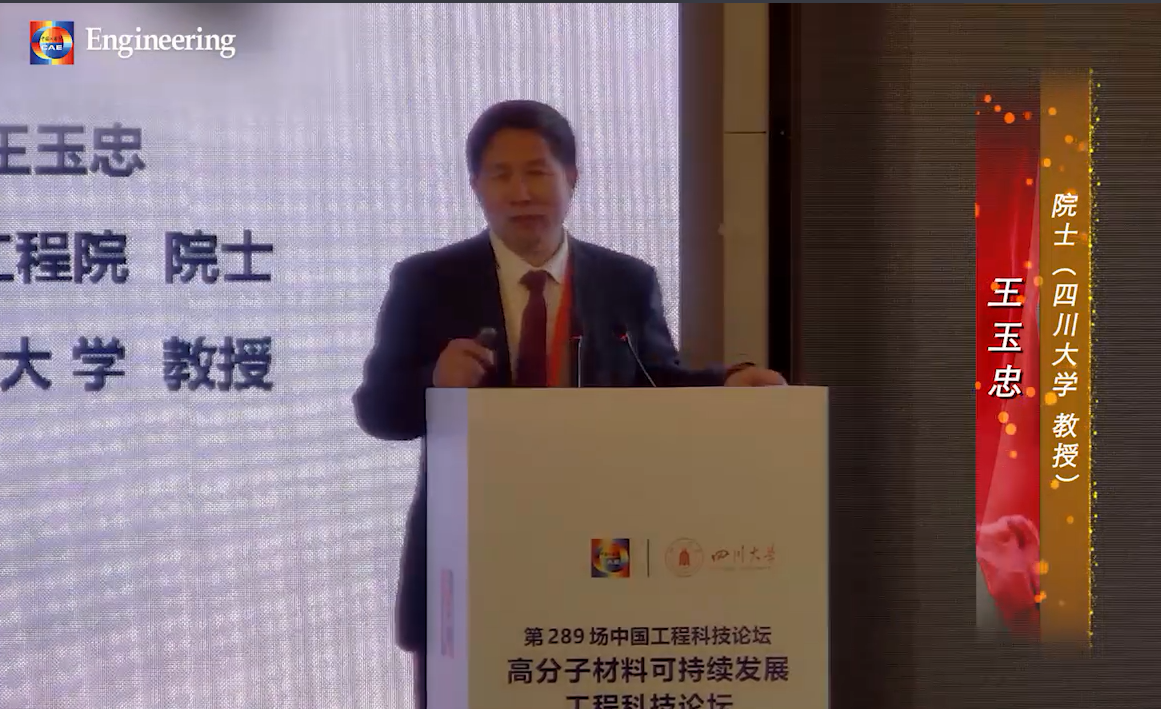Search scope:
排序: Display mode:
Biodegradable Materials and the Tissue Engineering of Nerves
Xiaosong Gu
Engineering 2021, Volume 7, Issue 12, Pages 1700-1703 doi: 10.1016/j.eng.2021.10.011
Advances in Soft Materials for Sustainable Electronics Review
Moon Jong Han, Dong Ki Yoon
Engineering 2021, Volume 7, Issue 5, Pages 564-580 doi: 10.1016/j.eng.2021.02.010
In the current shift from conventional fossil-fuel-based materials to renewable energy, ecofriendlymaterials have attracted extensive research interest due to their sustainability and biodegradable propertiesThe integration of sustainable materials in electronics provides industrial benefits from wasted bio-originThis review covers the use of sustainable materials as components in organic electronics, such as substrateshope this review will stimulate interest in the potential and practical applications of sustainable materials
Keywords: Sustainable Biodegradable Soft materials Organic electronics
Research Progress and Future Development of Nonferrous Biomedical Materials
Guan Shaokang, Zhu Shijie, ZhengYufeng, Wang Yunbing, Zhang Xingdong
Strategic Study of CAE 2023, Volume 25, Issue 1, Pages 104-112 doi: 10.15302/J-SSCAE-2023.01.008
Nonferrous biomedical materials have developed rapidly in recent yearsA variety of new nonferrous biomedical materials and devices that adapt to different in vivo environmentsThe research progress, development trend, and scientific issues of nonferrous medical materialsfor permanent implants, biodegradable nonferrous medical materials, porous nonferrous medical materials, and surface modification of nonferrous medical materials are reviewed.
Keywords: nonferrous biomedical materials nonferrous materials for permanent implants biodegradable nonferrousmedical materials porous nonferrous medical materials surface modification of nonferrous medical materials
Biodegradable, superhydrophobic walnut wood membrane for the separation of oil/water mixtures
Frontiers of Chemical Science and Engineering 2022, Volume 16, Issue 9, Pages 1377-1386 doi: 10.1007/s11705-022-2157-z
Keywords: wood nanotechnology superhydrophobic biodegradable surface modification oil/water separation
Frontiers of Chemical Science and Engineering 2023, Volume 17, Issue 10, Pages 1544-1554 doi: 10.1007/s11705-022-2288-2
Keywords: cellulose-based nanocomposite biodegradable antibacterial fabric nano-copper ions face masks
Micronization of curcumin with biodegradable polymer by supercritical anti-solvent using micro swirl
Kimthet Chhouk, Wahyudiono, Hideki Kanda, Shin-Ichro Kawasaki, Motonobu Goto
Frontiers of Chemical Science and Engineering 2018, Volume 12, Issue 1, Pages 184-193 doi: 10.1007/s11705-017-1678-3
Keywords: micronization curcumin polyvinylpyrrolidone supercritical anti-solvent swirl mixer
Jiaojiao Shang, Guo Yao, Ronghui Guo, Wei Zheng, Long Gu, Jianwu Lan
Frontiers of Chemical Science and Engineering 2018, Volume 12, Issue 3, Pages 457-466 doi: 10.1007/s11705-018-1716-9
Biodegradable poly(ether-imide-ester) elastomers were synthesized from succinic acid, 1,4-butanediol
Keywords: thermoplastic elastomers biodegradability thermo-stability mechanical property aromatic bisimide moiety
Biodegradable polymethacrylic acid grafted psyllium for controlled drug delivery systems
Ranvijay KUMAR, Kaushlendra SHARMA
Frontiers of Chemical Science and Engineering 2013, Volume 7, Issue 1, Pages 116-122 doi: 10.1007/s11705-013-1310-0
Keywords: psyllium acetyl salicylic acid in-vitro drug release swelling biodegradation
Challenges and Solutions for the Additive Manufacturing of Biodegradable Magnesium Implants Article
Yinchuan Wang, Penghuai Fu, Nanqing Wang, Liming Peng, Bin Kang, Hui Zeng, Guangyin Yuan, Wenjiang Ding
Engineering 2020, Volume 6, Issue 11, Pages 1267-1275 doi: 10.1016/j.eng.2020.02.015
Keywords: Additive manufacturing Selective laser melting Biodegradable Mg alloys Tissue engineering scaffolds

Wang Yuzhong: Recyclable Biodegradable Polymer Materials (2019.5.6)
王玉忠(院士)
27 Jan 2021
Keywords: 高分子材料
Replacing Traditional Plastics with Biodegradable Plastics: Impact on Carbon Emissions
Guanyi Chen,Jianyuan Li,Yunan Sun,Zhi Wang,Gary A. Leeke,Christian Moretti,Zhanjun Cheng,Yuan Wang,Ning Li,Lan Mu,Jinyu Li,Junyu Tao,Beibei Yan,Li´an Hou
Engineering 2024, Volume 32, Issue 1, Pages 153-162 doi: 10.1016/j.eng.2023.10.002
Keywords: Carbon emissions Biodegradable plastics Different disposal scenarios Daily life consumption Environmental
Hierarchically porous zeolites synthesized with carbon materials as templates
Frontiers of Chemical Science and Engineering 2021, Volume 15, Issue 6, Pages 1444-1461 doi: 10.1007/s11705-021-2090-6
Keywords: hierarchical zeolites carbon materials direct templates indirect templates carbon-silica composites
Influence of envelope insulation materials on building energy consumption
Junlan YANG, Jiabao TANG
Frontiers in Energy 2017, Volume 11, Issue 4, Pages 575-581 doi: 10.1007/s11708-017-0473-7
Keywords: building envelope insulation materials energy consumption payback time
Emerging electrochemical processes for materials recovery from wastewater: Mechanisms and prospects
Lingchen Kong, Xitong Liu
Frontiers of Environmental Science & Engineering 2020, Volume 14, Issue 5, doi: 10.1007/s11783-020-1269-2
Keywords: Materials recovery Electrosorption Capacitive deionization Redox processes Electrochemical precipitation
Frontiers in Energy 2023, Volume 17, Issue 3, Pages 320-323 doi: 10.1007/s11708-023-0889-1
Keywords: materials systems
Title Author Date Type Operation
Research Progress and Future Development of Nonferrous Biomedical Materials
Guan Shaokang, Zhu Shijie, ZhengYufeng, Wang Yunbing, Zhang Xingdong
Journal Article
Biodegradable, superhydrophobic walnut wood membrane for the separation of oil/water mixtures
Journal Article
Nano-copper ions assembled cellulose-based composite with antibacterial activity for biodegradable personal
Journal Article
Micronization of curcumin with biodegradable polymer by supercritical anti-solvent using micro swirl
Kimthet Chhouk, Wahyudiono, Hideki Kanda, Shin-Ichro Kawasaki, Motonobu Goto
Journal Article
Synthesis and characterization of biodegradable thermoplastic elastomers derived from N′,N-bis (2-carboxyethyl
Jiaojiao Shang, Guo Yao, Ronghui Guo, Wei Zheng, Long Gu, Jianwu Lan
Journal Article
Biodegradable polymethacrylic acid grafted psyllium for controlled drug delivery systems
Ranvijay KUMAR, Kaushlendra SHARMA
Journal Article
Challenges and Solutions for the Additive Manufacturing of Biodegradable Magnesium Implants
Yinchuan Wang, Penghuai Fu, Nanqing Wang, Liming Peng, Bin Kang, Hui Zeng, Guangyin Yuan, Wenjiang Ding
Journal Article
Wang Yuzhong: Recyclable Biodegradable Polymer Materials (2019.5.6)
王玉忠(院士)
27 Jan 2021
Conference Videos
Replacing Traditional Plastics with Biodegradable Plastics: Impact on Carbon Emissions
Guanyi Chen,Jianyuan Li,Yunan Sun,Zhi Wang,Gary A. Leeke,Christian Moretti,Zhanjun Cheng,Yuan Wang,Ning Li,Lan Mu,Jinyu Li,Junyu Tao,Beibei Yan,Li´an Hou
Journal Article
Influence of envelope insulation materials on building energy consumption
Junlan YANG, Jiabao TANG
Journal Article
Emerging electrochemical processes for materials recovery from wastewater: Mechanisms and prospects
Lingchen Kong, Xitong Liu
Journal Article








